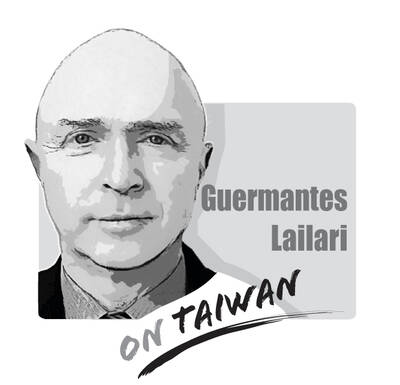“One China, two Taiwans” is a concept that was proposed by some academics several years ago. While the “one China” view is getting stronger, the “two Taiwans” has become adrift following the “rise” of China.
Association for Relations Across the Taiwan Strait (ARATS) Chairman Chen Yunlin (陳雲林) was wined and dined by former Chinese Nationalist Party (KMT) chairman Lien Chan (連戰) and People First Party Chairman James Soong (宋楚瑜), and pro-unification groups and people from the corporate sector also welcomed his visit last week. This is one of the two Taiwans.
On the other hand, Chen could not go to southern Taiwan and was in effect grounded in Taipei. The Democratic Progressive Party (DPP) staged protests and besieged the hotel where Chen was staying. Demonstrators tied protest ribbons around their heads and carried national flags. This is the other Taiwan. Under the shadow of “one China,” the “two Taiwans” failed to communicate with each other and were wary of each other, as if the real enemy for each of them were not in China, but in Taiwan.
Beijing has remained consistent in its “one China” policy, but has become much more flexible in its application. The Chinese government grasped the strategic advantage of the KMT’s return to power in May to confine the future development of Taiwan through various agreements signed by both sides. The KMT and the Chinese Communist Party have agreed to accelerate cross-strait talks within a short period of time, with the chairmen of the Straits Exchange Foundation (SEF) and ARATS holding talks twice this year.
This appears to contravene the Agreement on the Establishment of Systematic Liaison and Communication Channels between the SEF and the ARATS (兩岸聯繫與會談制度協議) signed at the talks between former SEF chairman Koo Chen-fu (辜振甫) and former ARATS chairman Wang Daohan (汪道涵) in Singapore in 1993, which stipulated that vice chairmen, rather than the chairmen, of both agencies should meet twice every year. SEF Chairman Chiang Pin-kung (江丙坤) and his ARATS counterpart said that they would expedite cross-strait relations despite voices of dissent within Taiwan. They were not deterred by a recent public opinion poll conducted by Taiwan’s Mainland Affairs Council that showed 30 percent of respondents worried that cross-strait exchanges were being pushed ahead too fast.
The agreements signed during this second round of talks between Chiang and Chen in regards to aviation routes, direct sea transportation links and postal services herald the arrival of the “major three links” era across the Taiwan Strait. The “three links”— direct postal sercices, transportation and trade — proposed by China in 1979 have finally come true. Article 95 of the Act Governing Relations Between Peoples of the Taiwan Area and the Mainland Area (兩岸人民關係條例) stipulates that “the competent authorities shall request the consent of the Legislative Yuan before permitting direct business transactions or direct sea or air transportation between the Taiwan Area and the Mainland Area.”
But the wording of the agreements says that they will take effect 40 days after being signed.
Meanwhile, the distance between Taiwan’s ruling and opposition parties seems farther than that between Taipei and Beijing.
The conflict between the pan-green camp and the pan-blue camp did not end after the presidential election, and cross-strait relations are the main focus of contention between the two parties. While welcoming Chen’s visit, the KMT has actually widened the gap between the “two Taiwans.”
Lin Cheng-yi is a research fellow at the Institute of European and American Studies at Academia Sinica.
TRANSLATED BY TED YANG
A response to my article (“Invite ‘will-bes,’ not has-beens,” Aug. 12, page 8) mischaracterizes my arguments, as well as a speech by former British prime minister Boris Johnson at the Ketagalan Forum in Taipei early last month. Tseng Yueh-ying (曾月英) in the response (“A misreading of Johnson’s speech,” Aug. 24, page 8) does not dispute that Johnson referred repeatedly to Taiwan as “a segment of the Chinese population,” but asserts that the phrase challenged Beijing by questioning whether parts of “the Chinese population” could be “differently Chinese.” This is essentially a confirmation of Beijing’s “one country, two systems” formulation, which says that

“History does not repeat itself, but it rhymes” (attributed to Mark Twain). The USSR was the international bully during the Cold War as it sought to make the world safe for Soviet-style Communism. China is now the global bully as it applies economic power and invests in Mao’s (毛澤東) magic weapons (the People’s Liberation Army [PLA], the United Front Work Department, and the Chinese Communist Party [CCP]) to achieve world domination. Freedom-loving countries must respond to the People’s Republic of China (PRC), especially in the Indo-Pacific (IP), as resolutely as they did against the USSR. In 1954, the US and its allies
Indian Prime Minister Narendra Modi arrived in China yesterday, where he is to attend a summit of the Shanghai Cooperation Organization (SCO) with Chinese President Xi Jinping (習近平) and Russian President Vladimir Putin today. As this coincides with the 50 percent US tariff levied on Indian products, some Western news media have suggested that Modi is moving away from the US, and into the arms of China and Russia. Taiwan-Asia Exchange Foundation fellow Sana Hashmi in a Taipei Times article published yesterday titled “Myths around Modi’s China visit” said that those analyses have misrepresented India’s strategic calculations, and attempted to view
When Chinese President Xi Jinping (習近平) stood in front of the Potala Palace in Lhasa on Thursday last week, flanked by Chinese flags, synchronized schoolchildren and armed Chinese People’s Liberation Army (PLA) troops, he was not just celebrating the 60th anniversary of the establishment of the “Tibet Autonomous Region,” he was making a calculated declaration: Tibet is China. It always has been. Case closed. Except it has not. The case remains wide open — not just in the hearts of Tibetans, but in history records. For decades, Beijing has insisted that Tibet has “always been part of China.” It is a phrase